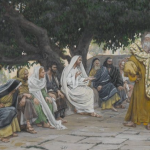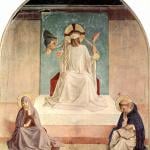We have recently (on my birthday, Nov. 4, in fact) lost one of the great thinkers of our time. While others have offered helpful introductions to his work (the interested reader might look at “Robert Barron, Rene Girard, Church Father,” “Rene Girard: Are The Gospels Mythical” and “The Scapegoat: Rene Girard’s Anthropology of Religion and Violence,” in order), I want to take this opportunity to reflect on a problem that Rene Girard has helped me to better understand, an issue that is of pressing apologetic value in our contemporary situation.
The New Atheism is quite fixated on the kind of god it believes is revealed by the Old Testament. In the words of Richard Dawkins, “The God of the Old Testament is arguably the most unpleasant character in all fiction: jealous and proud of it; a petty, unjust, unforgiving control-freak; a vindictive, bloodthirsty ethnic cleanser; a misogynistic, homophobic, racist, infanticidal, genocidal, filicidal, pestilential, megalomaniacal, sadomasochistic, capriciously malevolent bully.”
It is hard to square this with all that stuff about caring for widows and orphans, but I digress. The fact is that the Old Testament is, in fact, chock full of brutal scenes, some of which, at least, seem sanctioned by God.
In responding to the New Atheist critique, Robert Barron, for one, has turned to a spiritual reading of the Old Testament in the tradition of the Church Fathers. Here’s an example:
For Barron, it is important that contemporary Christians read certain scandalous passages allegorically. If God asks Saul to put the ban on the Amalekites, e.g., we must put the ban on sin in our lives.
And that way of reading Scripture is perfectly legitimate. Not only does it have a long history in the Church, stretching back to the Fathers, Scripture itself sometimes reads Scripture allegorically. Just think of Paul’s Old Adam and New Adam in Romans.
On the other hand, if you are like me, you might have the feeling that Bishop Barron has skipped a step somewhere. Surely it is legitimate to exhort the Christian people to battle sin without compromise when preaching on a text like the battle with the Amalekites. But is that what the text is actually trying to say? Did the writers of this text simply invent a story with an allegorical meaning? Or were they trying to say something to their own people and culture about the actual event in question?
Catholic biblical hermeneutics accepts what it calls “spiritual” senses of Scripture. (For more on this, see the Pontifical Biblical Commission’s excellent The Interpretation of the Bible in the Church, section II, Hermeneutical Questions.) That is the sense Barron is employing. But it insists that any spiritual sense must be anchored by the literal sense. “Literal” here does not mean “literalistic,” as in insisting that the world was created in seven literal days, but rather what the original authors and editors of the text were trying to communicate. So, in fact, a literal reading of the creation narratives in Genesis would involve determining which ideas the authors were explicitly rejecting from the dominant cultures surrounding them, e.g., that creation was the result of violence, or that the sun and moon were deities.
It is here that I find Girard extremely helpful. His work gives us powerful tools for discerning what was actually going on in a community that was producing certain texts and what those texts meant to that community.
A little background.
Girard discovered what he calls “the scapegoat mechanism” in his study of the literature of the west and then the mythology of the world. (If you’re not already familiar with this, now would be a good time to look at some of the introductory pieces linked to at the top.) In every culture, harmony is found by expelling and/or killing a common victim and so culture is founded on victims. Everywhere Romulus is killing Remus.
When Girard turns his attention to the Bible, he finds the exact same dynamic. Cain kills Abel and goes on to found culture.
But something vital is different in Scripture. It is not that the people behave any better. All of the things that people do are documented in the Old Testament: child sacrifice, ethnic cleansing, fratricide, etc. The difference is that, unlike the mythology of the world, the stories are told in a self-accusing way. Israel, somehow, looks unflinchingly at its own history and laments. Israel does not view Cain the way Rome views Romulus.
This is easier to see in some stories than others. It is fairly clear that God favours the victim in the Cain and Abel narrative. Less so in the Amalekite episode from 1 Samuel 15 referenced above. Nevertheless, even a cursory reading of 1 Samuel 15 shows a lot more ambiguity than the basic, God-commanded-genocide, interpretation. Indeed, Saul’s justification, that his decision not to apply the ban stemmed from a desire to present sacrifice to Yahweh, is roundly rejected with the Old Testament mainstay:
“Does the Lord delight in burnt offerings and sacrifices
as much as in obeying the Lord?
To obey is better than sacrifice,
and to heed is better than the fat of rams.”
And it is in such ambiguity that Girard finds the key to their meaning. Girard calls the Bible, especially the Old Testament, “a text in travail.” It is the beginning of the unmasking of the scapegoat mechanism by a people (like all peoples, including ourselves) still caught up in it. For Girard, the crucifixion and resurrection are the final unmasking of this mechanism, but the process begins with Israel, the people whose very identity was that of the expelled foreigner. It is this experience that gives Israel the tools to see the scapegoat mechanism in action even if it is also constantly participating in it.
Of course, this can lead to certain uncomfortable conclusions. It means, for instance, that not everything that Samuel thinks the Lord said is, in fact, what the Lord said. Samuel himself may be caught up in some scapegoating mechanism unwittingly and attributing things to God that are more realistically attributed to Samuel himself.
Let’s look at another aspect of the passage above.
What Saul fails to do is to enforce the ban. The ban, for Girard, is a sociological defense mechanism. Bringing in prized animals or foreign kings or treasure stoked the fires of jealousy in the camp and led to a social breakdown that could only be resolved by an episode of scapegoating. See, e.g., the episode of Achan in Joshua 7, masterfully treated in Gil Bailie’s Violence Unveiled.
Samuel recognized that the plunder must be destroyed before it destroys the community. Hence, he puts “Agag to death before the Lord at Gilgal,” a dead giveaway that this is an act of ritual sacrifice designed to mollify the crowd. Samuel, therefore, recognizes in principle that sacrifice is not what God wants, and says as much, but cannot avoid sacrifice himself. In this he is, in fact, a microcosm of the whole Old Testament.
It may be uncomfortable to think that perhaps not everything attributed to Yahweh by the authors of Scripture should be literalistically understood to be such by us, but the text itself is full of such warnings. Read Obadiah. It is easily the most xenophobic book of prophecy in the Hebrew Scriptures. And what did the editors choose to put right after Obadiah? Jonah – whose brilliant last line is: “And should I not have concern for the great city of Nineveh, in which there are more than a hundred and twenty thousand people who cannot tell their right hand from their left—and also many animals?”
Scripture is not God-dictated. It is, as we learn from the Incarnation, the Pontifical Biblical Commission insists, fully human and fully divine. It is a story by and about humans that is, at the same time, by and about God. God speaks to us through Scripture by speaking to us through the sins and errors of humanity. This makes reading Scripture a complex task, for it is sometimes difficult to realize that God does not endorse something just because his book describes it.
On the other hand, it is often much easier than we are given to believe. If the New Atheist reading of Abraham and Isaac on Mount Moriah was the right reading, we should expect it to lead to the flourishing and endorsement of child sacrifice in ancient Israel. What we see instead is the marginalization and eventual extinction of the practice, first in Israel, and then, through Israel, the whole world. Even if the New Atheists can’t bring themselves to see what God is saying in such a text, ancient Israel could.
And this returns us to Barron’s opening point. Scripture must be read in light of Scripture. The whole canon informs how we should interpret questionable or difficult passages. A Girardian reading of certain difficult texts might seem forced on occasion. It may even be forced. Not every possible Girardian reading is necessarily accurate. Nevertheless, if the Girardian reading leads to an understanding of the passage that harmonizes that passage with the basic pattern of Scripture, it deserves a serious hearing.
In listening to Girard and his interpreters read the Old Testament we have a great apologetic tool at hand, for with their insights we need not skip over the literal meaning in favour of a more spiritual sense that seems to ignore that the Bible actually does seem to say that God commanded things like ethnic cleansing. With Girard we are able to discern the ambiguities in the texts that hint that there is often more to the literal sense than we might have suspected – a more that coheres with, rather than opposes, the spiritual sense.
Brett Salkeld is Archdiocesan Theologian for the Catholic Archdiocese of Regina, Saskatchewan. He is a father of four (so far) and husband of one.












